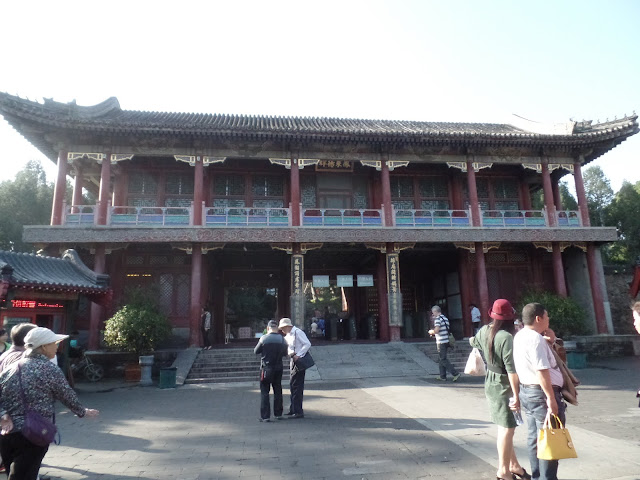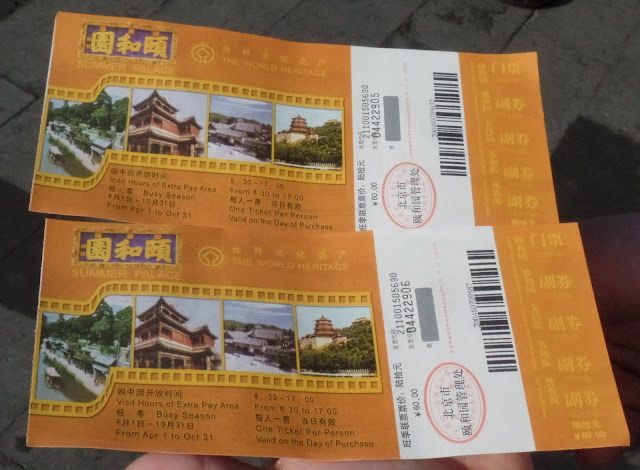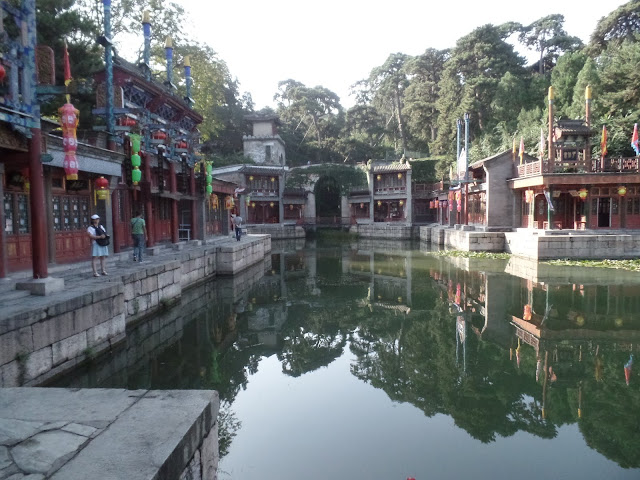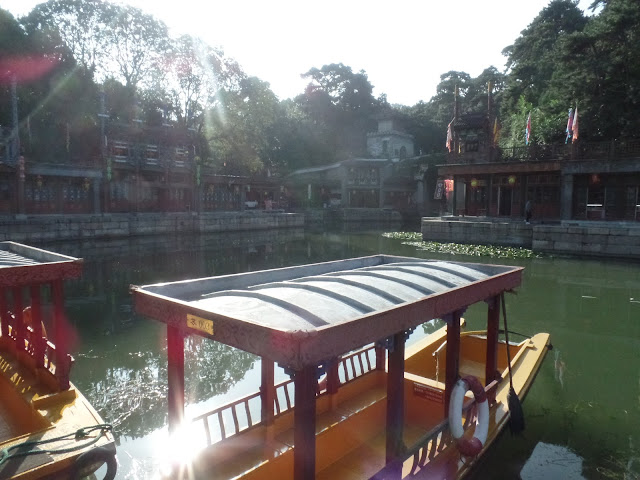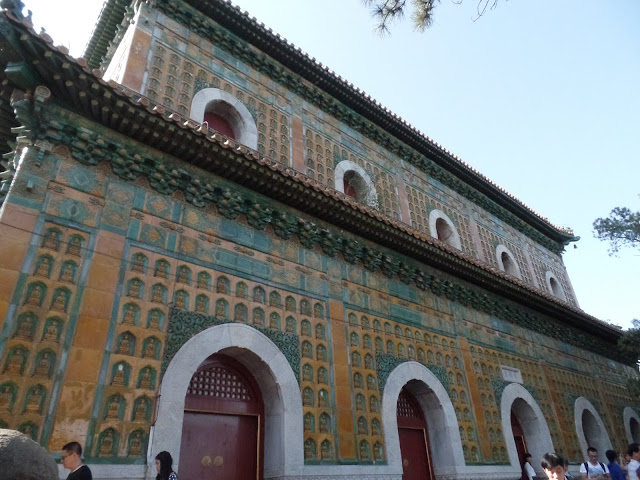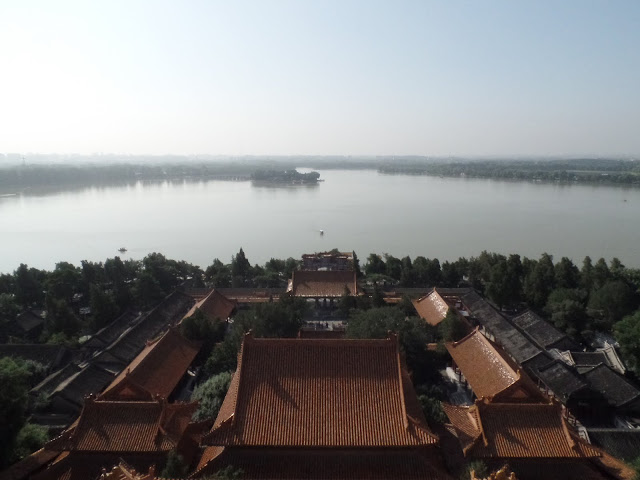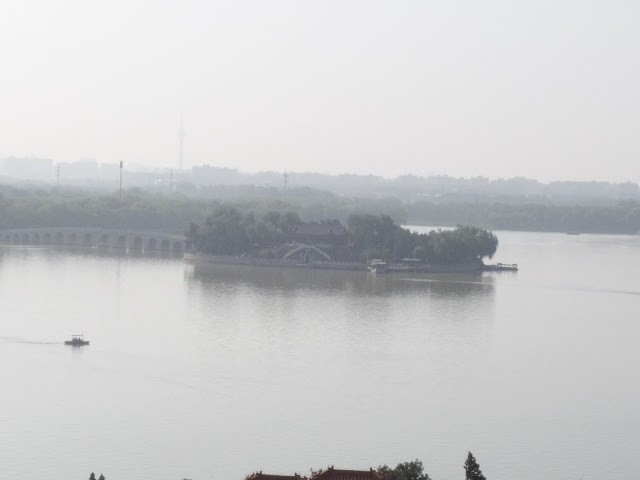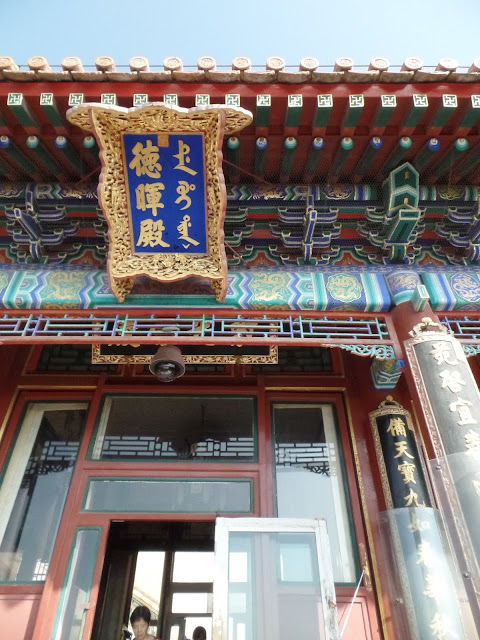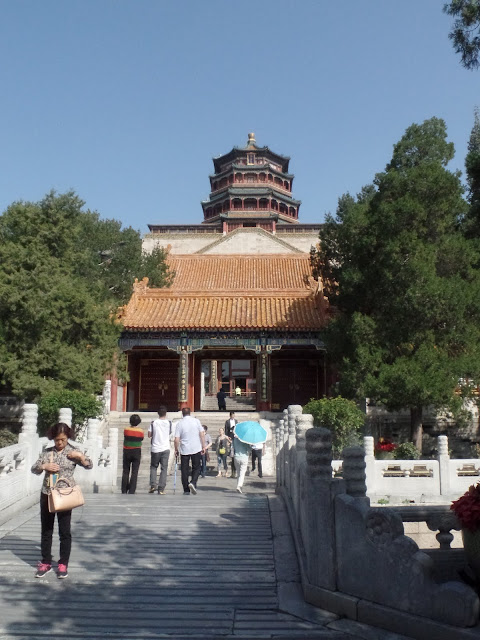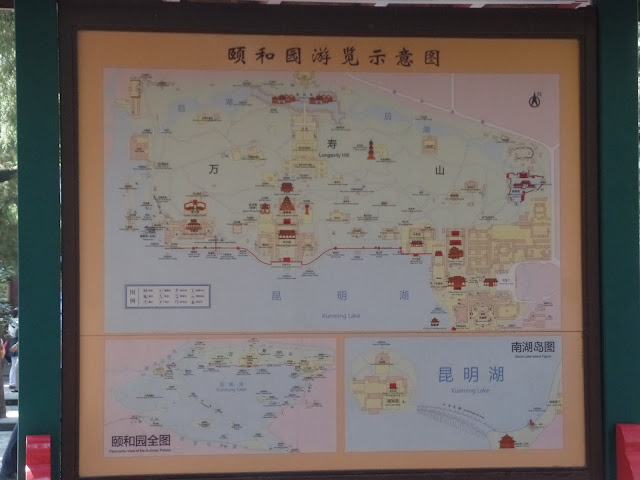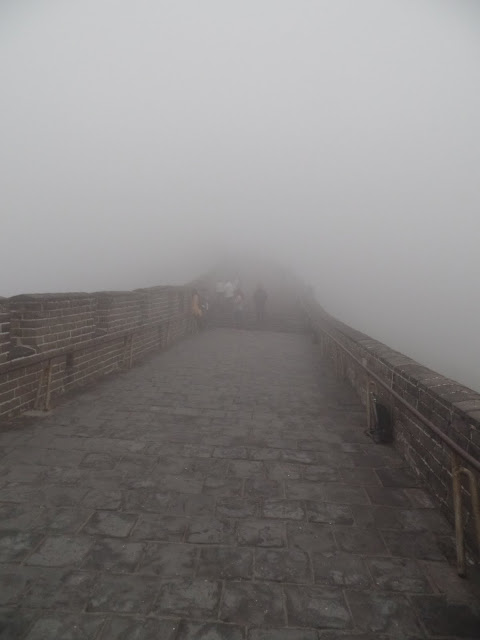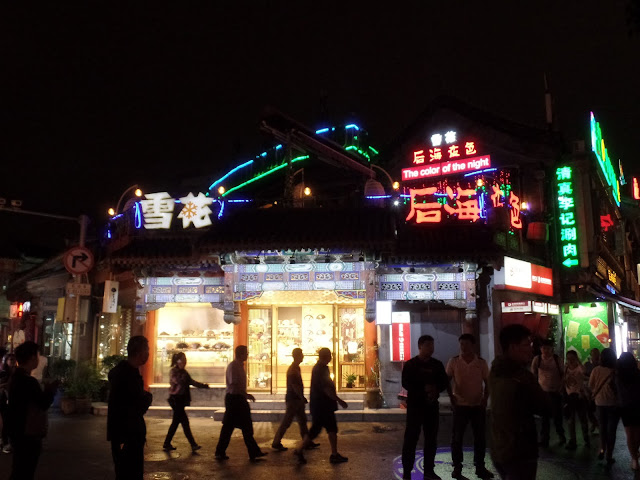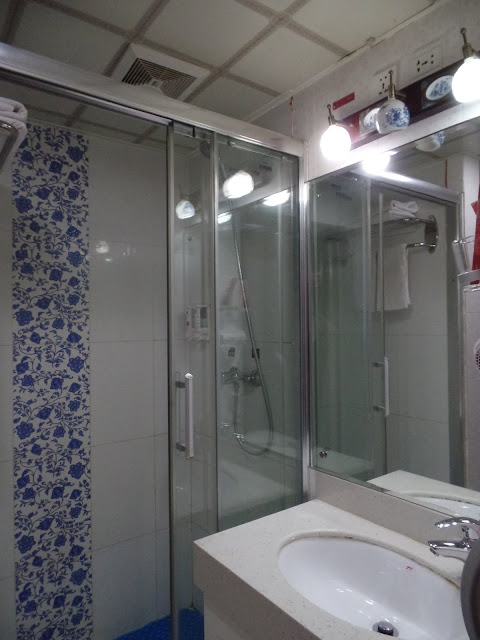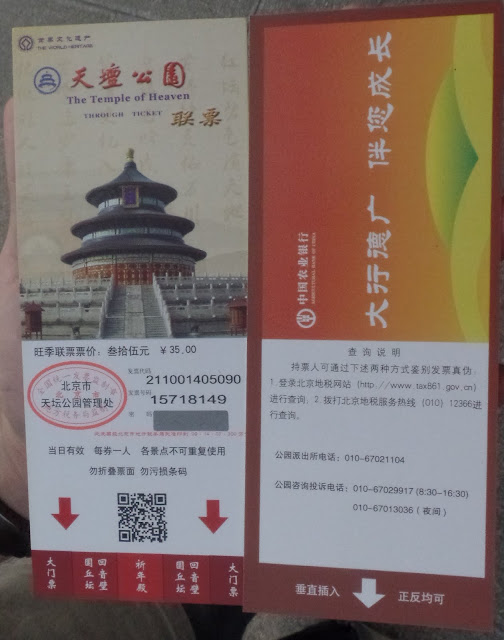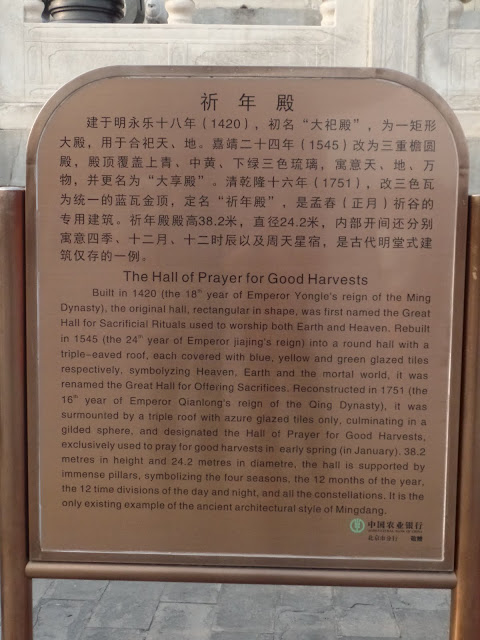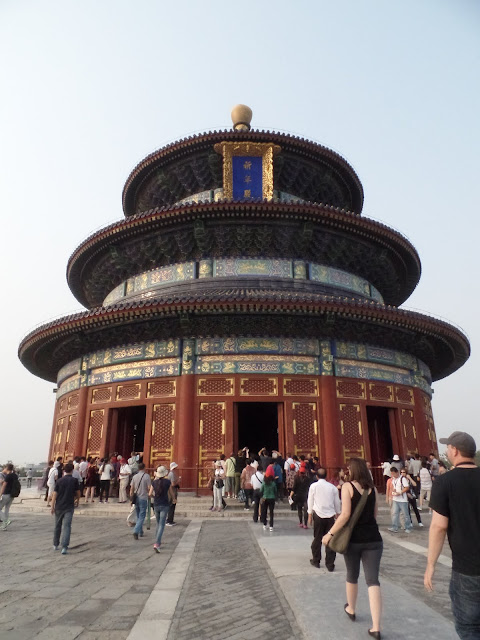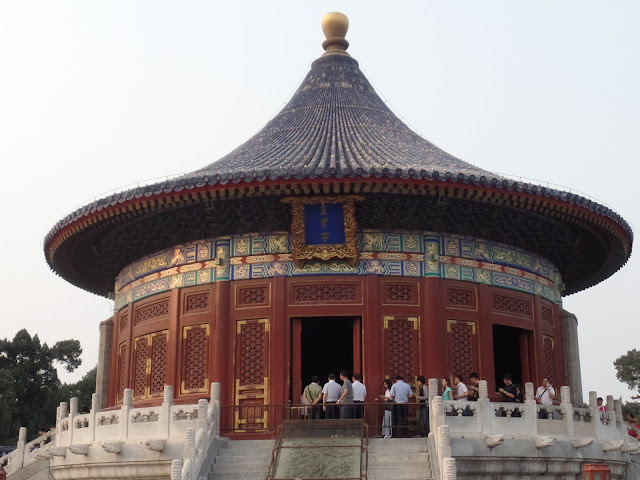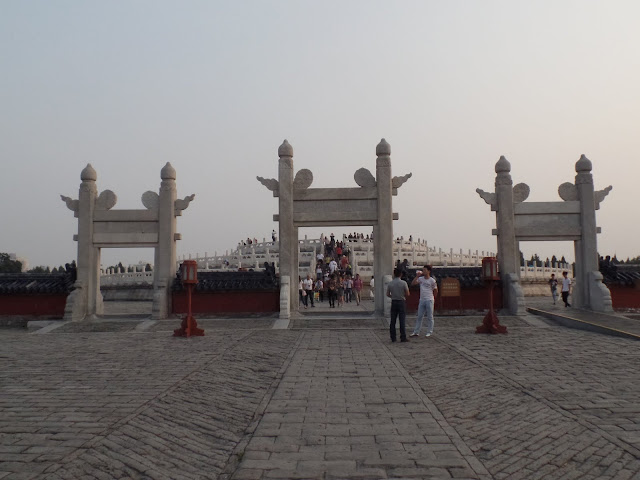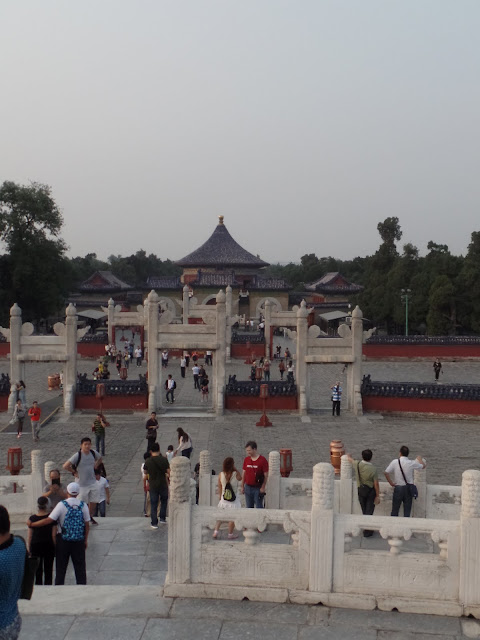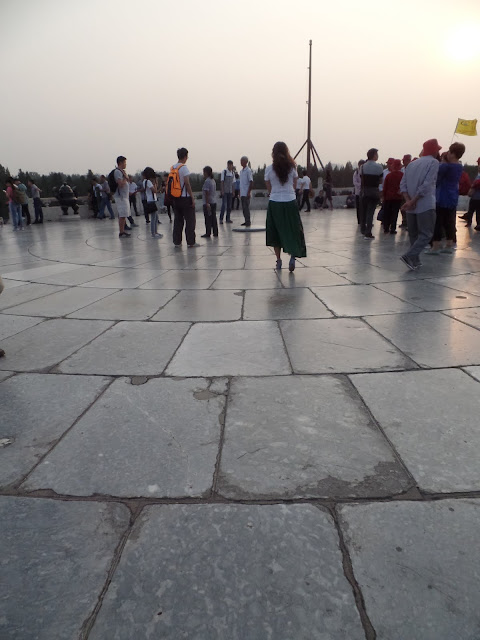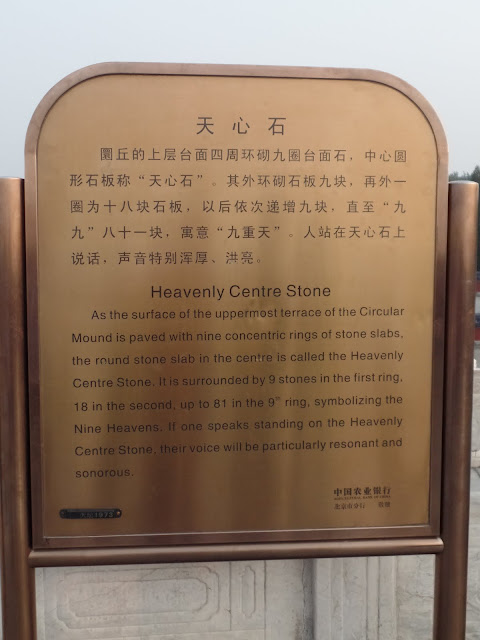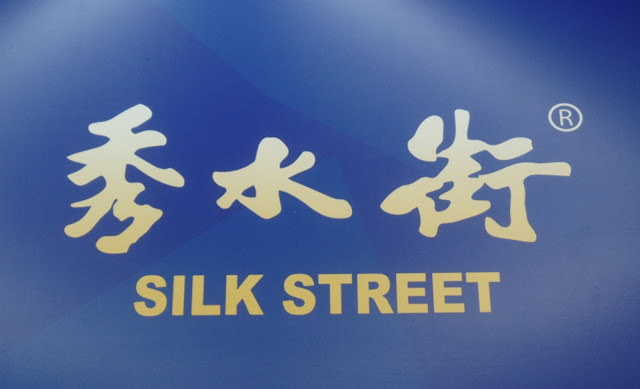On this day, we would make a visit to 2 UNESCO World Heritage Sites located outside the urban Beijing city centre, the Badaling section of Great Wall (长城 - 八达岭) and the Ding Ling (定陵) [one of the Ming 13 Tombs (明十三陵)]. We took an early MRT train ride to Xizhimen Station (西直门), which is not far away from Andingmen Station (安定门). The Xizhimen Station (西直门) is directly linked to the Beijing North Railway Station (北京北站), which we bought the next available tickets (paid by Yikatong (一卡通)) for the Suburban Line S2. By this time, we could already see a long queue outside the gate to the S2 train. Once the gate was opened for boarding, the crowd simply rushed towards the train to grab the seats, since it was free seating. We were lucky to get our seats too and soon all the seats were occupied, while the rest of the passengers had to stand. The train ride to Badaling (八达岭) station is more than an hour, and most passengers will only alight at the Badaling (八达岭) station, thus it's better to be seated!
Great Wall - Badaling (长城 - 八达岭)
The Great Wall of China (万里长城) is a series of fortification walls built by the ancient Chinese states against raids by the nomadic tribes from the north of Central Plain. The earlier wall sections were built during Warring States era and more famously by Qin Shi Huang (秦始皇), the first Emperor of China. Only few sections of the wall during that period survived. The wall that we see today is mainly repaired and widely expanded during the Ming dynasty. There are a number of wall sections near to Beijing that tourists could visit. The well preserved and more tourist friendly sections are Badaling (八达岭), Mutianyu (慕田峪) and Juyongguan (居庸关), but they are also the place with many tourists. The less restored sites are Simatai (司马台) and Jinshanling (金山岭), where they have lesser tourist crowd.
We reached the Badaling (八达岭) station at around 9.45am and almost everyone alighted here. Once outside the station, we found the weather much cooler than the city centre and the air was foggy.
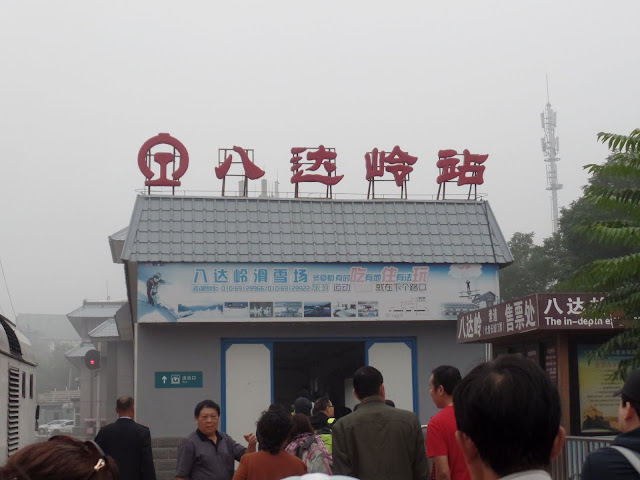 |
| Arrived Badaling Railway Station |
From the train station, we had to walk for another 15-20 min to reach the ticket office. The entrance ticket also includes a "Hero Certificate", which you can write down your name to certify you had climbed the Great Wall.
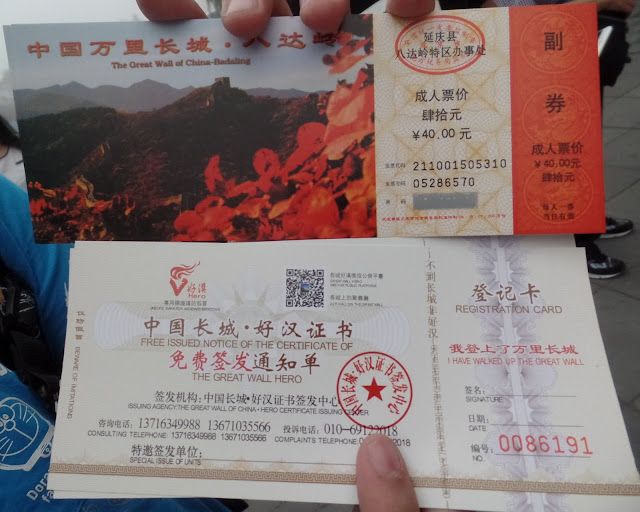 |
| Badaling Great Wall entrance ticket and the Hero Certificate |
As we approached the main entrance, the whole area was getting foggier. This became the biggest disappointment for our entire China tour. The visibility was poor and thus we were not able to see the magnificent view of the Great Wall winding along the lush green mountain range. Nevertheless, we still went ahead to climb the wall.
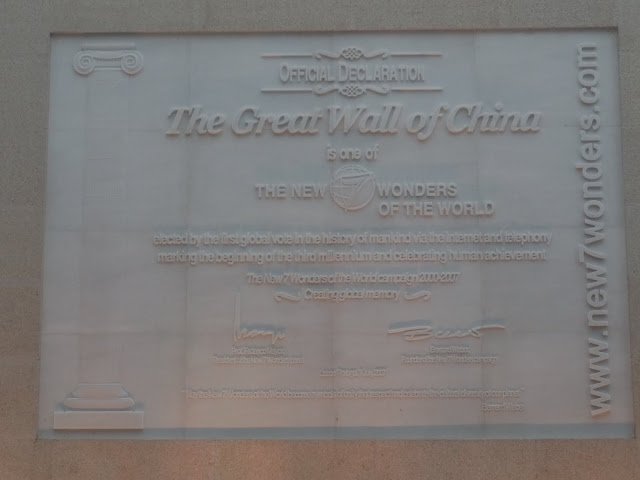 |
| Declaration for The Great Wall of China as New 7 Wonders of the World |
We only planned to climb the northern section, starting from No.1 North Tower at around 10.30am. From No. 1 to No. 8 North Tower (highest point), the climb is uphill. Initially the slope is still gentle, but from No. 3 North Tower onward, the slope and stairs are steeper, which we had to make frequent rests.
 |
| Entrance to the Northern Towers |
 |
| Thick fog at the Great Wall |
We took around an hour to reach No. 8 North Tower. Over here, we could find the cable station which allows those who are not physically fit to come up via the cable car to enjoy the view at the highest point.
 |
| Badaling Great Wall No. 8 North Tower |
We rested for a while before we descend the wall towards the No. 12 North Tower. Throughout this section, it was less crowded. The slope is very steep here and we had to hold tight to the railing while descending the steps. It took us another 45min before we reached the No. 12 North Tower and exited the wall.
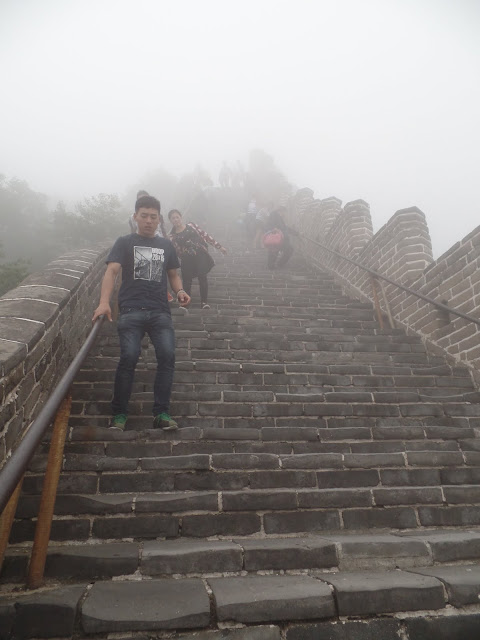 |
| Descending down the steep steps towards No. 12 North Tower |
From the wall, the road led us to a place where there's many merchant stalls selling souvenirs, food and drinks. Along the way, we also passed by a Bear Park, with many sun bears in enclosure. Visitors could also buy food to feed the bears.
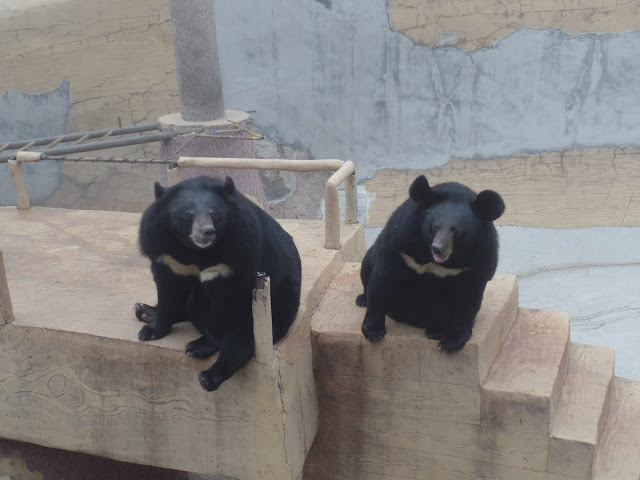 |
| Sun bears at the Bears Park |
After some time, we reached the Bus Terminal, where we had our lunch at the food court. After our lunch, we waited for the Bus 879 to our next destination.
Ming 13 Tombs - Ding Ling (明十三陵 - 定陵)
Ming 13 Tombs (明十三陵) refers to the collection of imperial tombs of the 13 Ming dynasty emperors and their royal family members around the foot of Tianshou Mountain (天寿山). The entire region is very large, which in addition to the tombs, also consists of the 7km long Sacred Way (神道). Out of all the tombs, only 3 of them [Chang Ling (长陵), Ding Ling (定陵) and Zhao Ling (昭陵)] are opened to public, along with the Sacred Way (神道). Chang Ling (长陵) is the most famous one, as its complex is the largest and most elaborated, as well as the owner [Emperor Yongle (永乐皇帝)] is also the most popular and respected among the Ming emperors. However, we did not visit Chang Ling (长陵), but only Ding Ling (定陵) instead. This is because Ding Ling (定陵) is the only tomb that has been fully excavated and visitors could enter the underground palace. There are more things to see as compared to the other two, which visitors only get to see the exterior. Ding Ling (定陵) is the burial tomb of Emperor Wanli (万历皇帝) and his two empresses, Empress Xiaoduanxian (孝端显皇后) and Empress Xiaojing (孝靖皇后).
From the Great Wall Badaling (八达岭) bus terminal, we took the ride on Bus 879 for around an hour to Ding Ling (定陵). The same Bus 879 will terminate at the Chang Ling (长陵) and the Ding Ling (定陵) station is the second last stop. Once we alighted, it was just a short walk to the ticket office to buy the entrance tickets.
 |
| Ming 13 Tombs - Ding Ling entrance tickets |
 |
| Ding Ling Tomb Museum |
 |
| Introduction of Ming 13 Tombs |
 |
| Introduction of Ding Ling |
By this time, the sky started to drizzle, the first rain for my China tour so far. We walked through the large rectangular shape court yard, where we passed by the ruins of Ling'en Gate (祾恩门) and Ling'en Hall (祾恩殿). We did not see any structure at all, except for the platform that was still visible. The rest of the structures were already destroyed. After this is the Lingxing Gate (棂星门), which is still standing after restoration. Over here, we could see the Five Offerings (五供) for sacrificial offerings.
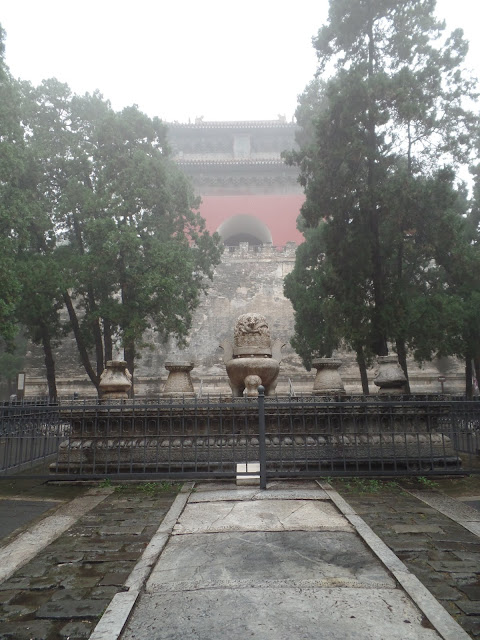 |
| Five Offerings with the Soul Tower at the back |
There're two exhibition halls over here, one on the left and the other on the right. The exhibition halls introduce the history and life of the tomb occupants (the emperor and his empresses), as well as exhibits of many of the unearthed sacrificial relics from the tomb.
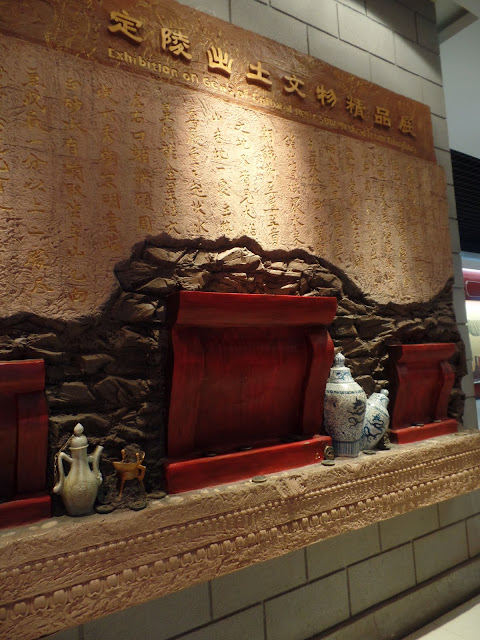 |
| Entrance to the Unearthed Relics Exhibition |
 |
| Emperor's Gold Crown |
 |
| Empress's Nine Dragon Nine Phoenix Headdress |
 |
| The emperor's robe |
 |
| The empress's robe |
 |
| Layout model of Ding Ling |
We followed the pathway and skirt around the Soul Tower (明楼) and mound to reach the entrance to the underground palace. This is not the original entrance of the underground palace, but a newly dug staircase that leads deep to one of the chamber of the underground palace.
We did not take any photographs inside the underground palace, as it is believed by the Chinese to be inauspicious to take photos inside a burial tomb. Just type "ming ding ling" and search images on Google, you will be able to see many photos of the interior of the underground palace. The entire underground palace is built using stone bricks. It's not very big and consists of 5 chambers. The left and right chambers are empty, which is believed for the emperor's concubines. In the middle chamber, we could see 3 stone thrones of the emperor and empresses in the centre of the chamber. The rear chamber is the most impressive, which we could see 3 wooden coffins and many smaller boxes, all coloured in red. Note that all these are replicas, as the original ones have already decayed. In the Museum of the Ming Tombs (明十三陵博物馆), visitors would get to see the photos of the original conditions when the archaeologists first entered the chamber. The largest coffin belongs to the emperor, flanked by 2 smaller coffins of the empresses. The smaller boxes contain the sacrificial items, which are now on exhibit in the 2 exhibition halls at the courtyard and the Museum of the Ming Tombs (明十三陵博物馆). At the antechamber, there's a TV set that shows the documentary on how the archaeologists first managed to open the locked marble door, which has a self locking mechanism that seems impossible to unlock at first. After this, we passed through the Diamond Wall (which is the original entrance to the underground palace) and exited the place.
Once out of the underground palace, we visited the Soul Tower (明楼) where we could see a giant stele that carries the inscriptions "Great Ming" (大明) and "The Mausoleum of Emperor Shenzong" (神宗显皇帝之陵). From here, we walked towards the entrance. Near to the ticket office, there's another exhibition hall named Museum of the Ming Tombs (明十三陵博物馆). This place is not very big and it introduces the history and life of all the Ming emperors and their burial tombs. There's also a lot of information and photographs related to the excavation of Ding Ling (定陵) underground palace, along with many exhibits on the unearthed treasures from the underground palace.
 |
| Emperor's Hat |
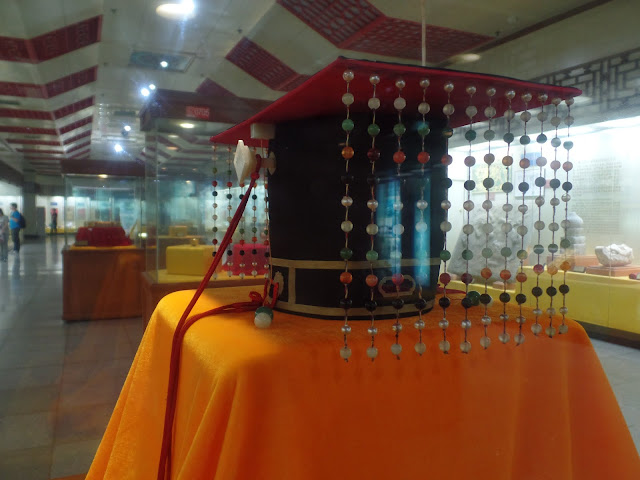 |
| Emperor's Flat Bead Crown |
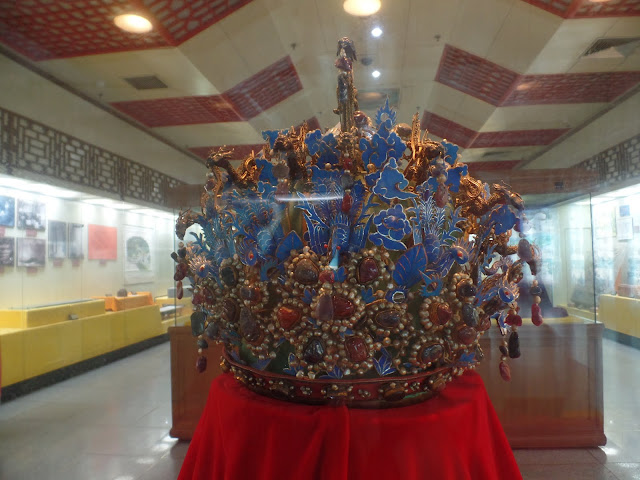 |
| Empress's Twelve Dragon Nine Phoenix Headdress |
After this we left the place and took Bus 872 to Deshengmen (德胜门
).
Shizhahai (什刹海)
The bus ride from Ding Ling (定陵) to Deshengmen (德胜门) took around 1.5 hours. By the time we reached Deshengmen (德胜门), it was already dark. From Deshengmen (德胜门), we walked to the north bank of Houhai (后海), then stroll along the bank towards the Yinding Bridge (银锭桥), the place where we went to on
Day 1. The night atmosphere at Shizhahai (什刹海) was completely different from the day time. Rows of pubs and restaurants were decorated with colourful lights and loud music playing from almost every pub.
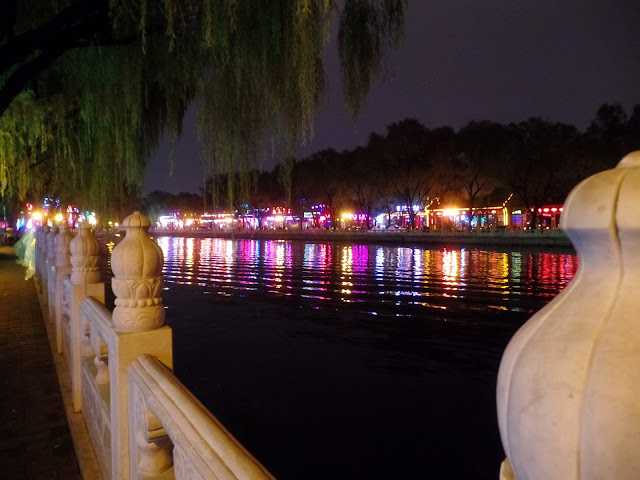 |
| Night view of Houhai |
We went to a western restaurant near the Yinding Bridge (银锭桥) to have our dinner, which we ordered spaghetti. After dinner, we took the MRT back to our hotel and called it a day.
Follow the links below to the other days of my China tour:
Day 1: Beijing (Yonghe Lama Temple, Shizhahai, Prince Gong Mansion, Behai Park, Gui Jie)
Day 2: Beijing (Tiananmen Square, Forbidden City, Old Summer Palace, Wangfujing)
Day 3: Tianjin (Italian Style Town, Nanshi Food Street, Drum Tower, Ancient Cultural Street, Quanjude Peking Roast Duck)
Day 4: Xi'an (Muslim Street, Drum Tower, Bell Tower, Xi'an City Wall, Defu Alley)
Day 5: Xi'an (Terracotta Army Museum, Da Ci'en Temple, Big Wild Goose Pagoda, Tang Paradise)
Day 6: Huashan
Day 7: Beijing (Temple of Heaven, Silk Street)
Day 8: Beijing (Great Wall - Badaling, Ming 13 Tombs - Ding Ling, Shizhahai)
Day 9: Beijing (Summer Palace)
